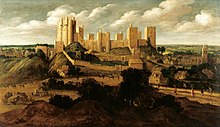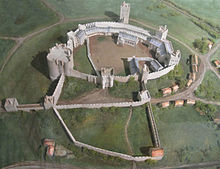Pontefract Castle

Pontefract Castle is a ruined castle near the town of Pontefract , part of the City of Wakefield in the English administrative unit of West Yorkshire . King Richard II is said to have died there. During the English Civil War of the 17th century there were several famous sieges of the castle.
history
The castle on a rock east of the city, above the All Saints Church, was built around 1070 for Ilbert de Lacy . He received the land for this from William the Conqueror as a reward for his support during the conquest of England . But there is also evidence of an earlier settlement of the site. Initially the castle was made of wood, but was later replaced by stone buildings. In the Domesday Book of 1086 there is "Ilbert's Castle", which probably means Pontefract Castle.
Robert de Lacy did not support King Henry I in his power struggle against his brother and so the king confiscated the castle from the family in the 12th century. Roger de Lacy paid King Richard I 3,000 marks for the Honor of Pontefract , but the king kept the castle. His successor, King Johann Ohneland , gave de Lacy a fiefdom in 1199, the year he acceded to the throne. Roger de Lacy died in 1213 and his eldest son, John de Lacy , inherited him. But now the king appropriated Castle Donington and Pontefract Castle. The De Lacys lived in the castle until the beginning of the 14th century. The great keep was built under their aegis .
In 1311 the castle passed into the hands of the House of Lancaster through marriage . Thomas Plantagenet, 2nd Earl of Lancaster , (1278-1322) was beheaded in front of the castle walls six days after his defeat in the Battle of Boroughbridge . He had been condemned to do so by King Edward II himself in the great hall. The earl became a martyr and his grave in the priory became a shrine. The castle then fell to Henry of Grosmont, 1st Duke of Lancaster , and then to John of Gaunt , the third son of King Edward III. He made the castle his personal residence and invested large sums in its expansion.
Richard II
King Richard II (1367–1400) was presumably murdered in the castle, in the Gascogne Tower . In William Shakespeare's drama Richard III. this incident is dealt with:
- Pomfret, Pomfret! O thou bloody prison,
- Fatal and ominous to noble peers!
- Within the guilty closure of your walls
- Richard the second here was hack'd to death;
- And, for more slander to thy dismal seat,
- We give thee up our guiltless blood to drink.
(Eng .: Pontefract, Pontefract! O you damned prison, / Deadly and ominous for nobles! / In your guilty walls / Richard the Second was hacked to death / And, for an even greater slander of your gloomy seat / we give you our innocent blood to drink.)
Tudor period
In 1536 the castle guard Thomas Darcy, 1st Baron Darcy de Darcy , handed the castle over to the leaders of the Pilgrimage of Grace , a Catholic rebellion from northern England against the reign of Henry VIII. Lord Darcy was charged with this alleged "task", which the king saw as treason , executed.
In 1541, while the king was on a trip through his provinces, it was said that Henry's fifth wife, Queen Catherine Howard , committed her first adultery with Sir Thomas Culpeper at Pontefract Castle, a crime for which she was apprehended and executed without trial. Mary Queen of Scots was staying at the castle on January 28, 1569 when she was traveling from Wetherby to Rotherham .
Royalist retreat
The castle had been in ruins since 1644 as it served as a retreat for the royalists during the English Civil War and was besieged at least three times by the Roundheads , the latter being responsible for the castle's current poor condition and much of its damage. Oliver Cromwell , leader of the parliamentarians, described Pontefract Castle as "(...) one of the strongest inland garrisons in the entire kingdom."
Obviously the demolition of the castle as a result of the Second English Civil War had the full support of the people living in the area. They were happy to be able to destroy the castle and thus end the fighting in their area. In the eyes of the people who lived here, the castle was a magnet for trouble.
Even today you can visit the cellars of the castle from the 11th century, which were used to store military equipment during the civil war.
ruins
Little of what must once have been “one of the most impressive castles in Yorkshire” has survived to this day, only parts of the curtain wall and hollowed-out and smoothed inner walls. The castle had a bailey and an inner bailey . Parts of the walls from the 12th century and the back door of the Piper Tower , as well as the foundations of the chapel are the oldest remains. The ruins of the Round Tower or Donjon are on the 11th century rampart. The Great Gate , flanked by semicircular towers from the 14th century, had an inner and an outer barbican . Chambers, which were carved into the rock in the main castle, probably show the location of the old knight's hall and the gate to the northern courtyard can be identified by the remains of a rectangular tower.
The most notable detail of the current site are the remains of the donjon. There are only a few examples of this type. One of them is Clifford's Tower in nearby York . A similar example as in York can also be found in the castle of Étampes in France.
Individual evidence
- ^ A b Nikolaus Pevsner, Enid Radcliffe: Yorkshire: The West Riding in The Buildings of England . 2nd Edition. Penguin Books, 1967. ISBN 0-14-071017-5 . P. 394.
- ↑ a b c d The Duchy of Lancaster - Yorkshire . www.duchyoflancaster.co.uk. Retrieved June 24, 2015.
- ↑ a b c d e Pontefract Castle Index . www.pontefractus.co.uk. Archived from the original on May 16, 2008. Info: The archive link was automatically inserted and has not yet been checked. Please check the original and archive link according to the instructions and then remove this notice. Retrieved June 24, 2015.
- ↑ CG Harfield: A hand-list of Castles Recorded in the Domesday Book in The English Historical Review . No. 106 (1991). P. 383.
- ^ Reginald Allen Brown: A List of Castles, 1154-1216 in The English Historical Review . Volume 74 (1959). P. 255.
- ^ A b Pontefract Castle . www.wakefieldmuseums.org. Retrieved July 22, 2008.
- ^ Calendar State Papers Scotland . Volume 2 (1900). P. 612.
Web links
- Pontefract Castle . Gatehouse Gazetteer.
- A right royal castle ... BBC home.
- Richard Bell. Pontefract Castle . WildYorkshire.co.uk.
- Pontefract Castle . Wakefield Council.
Coordinates: 53 ° 41 ′ 44 " N , 1 ° 18 ′ 14" W.


